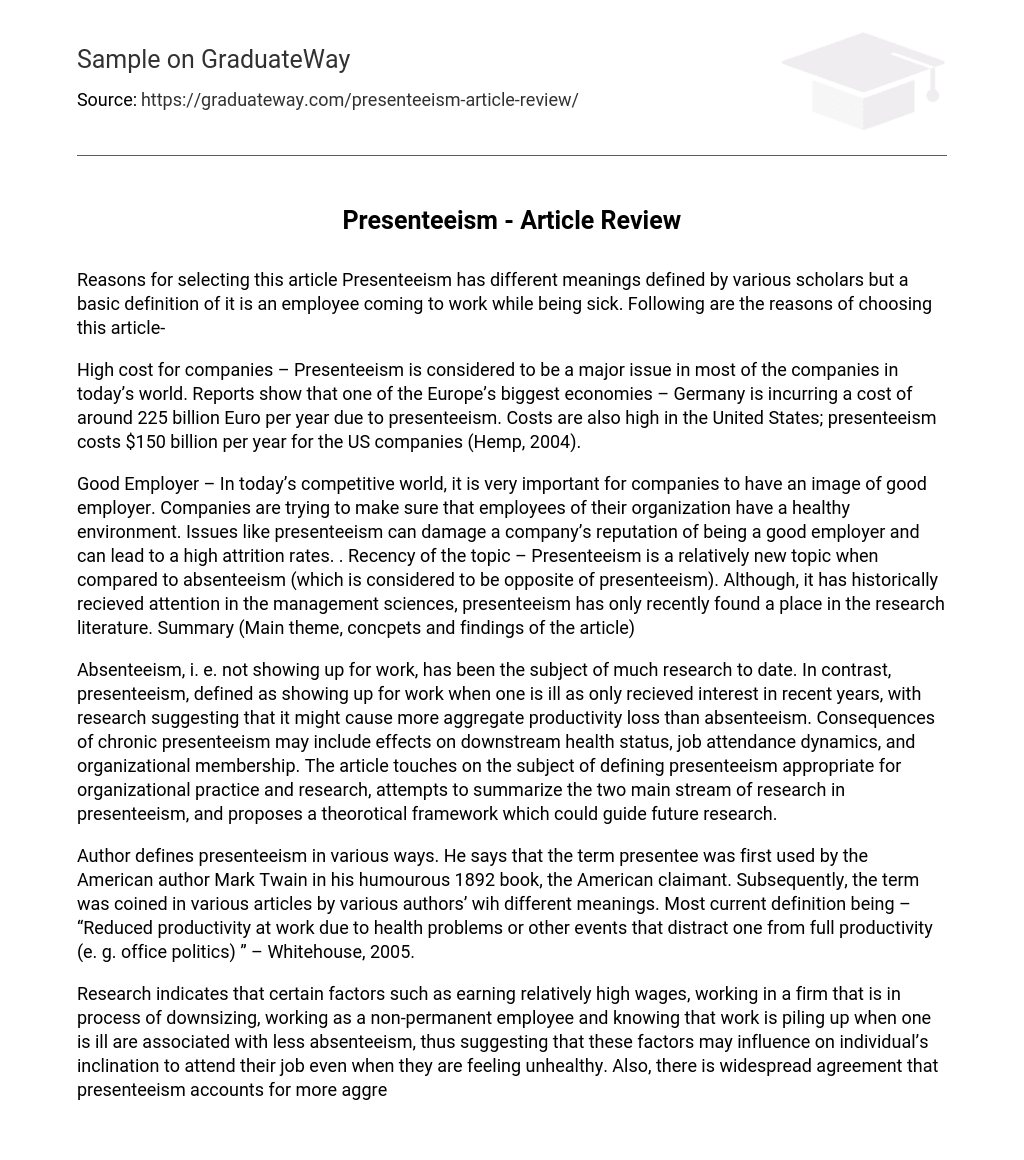Reasons for selecting this article Presenteeism has different meanings defined by various scholars but a basic definition of it is an employee coming to work while being sick. Following are the reasons of choosing this article-
High cost for companies – Presenteeism is considered to be a major issue in most of the companies in today’s world. Reports show that one of the Europe’s biggest economies – Germany is incurring a cost of around 225 billion Euro per year due to presenteeism. Costs are also high in the United States; presenteeism costs $150 billion per year for the US companies (Hemp, 2004).
Good Employer – In today’s competitive world, it is very important for companies to have an image of good employer. Companies are trying to make sure that employees of their organization have a healthy environment. Issues like presenteeism can damage a company’s reputation of being a good employer and can lead to a high attrition rates. . Recency of the topic – Presenteeism is a relatively new topic when compared to absenteeism (which is considered to be opposite of presenteeism). Although, it has historically recieved attention in the management sciences, presenteeism has only recently found a place in the research literature. Summary (Main theme, concpets and findings of the article)
Absenteeism, i. e. not showing up for work, has been the subject of much research to date. In contrast, presenteeism, defined as showing up for work when one is ill as only recieved interest in recent years, with research suggesting that it might cause more aggregate productivity loss than absenteeism. Consequences of chronic presenteeism may include effects on downstream health status, job attendance dynamics, and organizational membership. The article touches on the subject of defining presenteeism appropriate for organizational practice and research, attempts to summarize the two main stream of research in presenteeism, and proposes a theorotical framework which could guide future research.
Author defines presenteeism in various ways. He says that the term presentee was first used by the American author Mark Twain in his humourous 1892 book, the American claimant. Subsequently, the term was coined in various articles by various authors’ wih different meanings. Most current definition being – “Reduced productivity at work due to health problems or other events that distract one from full productivity (e. g. office politics) ” – Whitehouse, 2005.
Research indicates that certain factors such as earning relatively high wages, working in a firm that is in process of downsizing, working as a non-permanent employee and knowing that work is piling up when one is ill are associated with less absenteeism, thus suggesting that these factors may influence on individual’s inclination to attend their job even when they are feeling unhealthy. Also, there is widespread agreement that presenteeism accounts for more aggregate productivity loss than absenteeism – “On the face of it, this suggests an iceberg effect in which more visible portion beneath the surface (presenteeism)”.
This does not mean that productivity could be enhanced if people were advised that while productivity could be enhanced if people were advised not to show up for work when they are ill, but rather indicates that while productivity loss from absenteeismmay be high, productivity loss from presenteeism is probably higher, because it is more prevalent then absenteeism, but much less accounted for.
Critical Analysis of the article
- Not all the factors are included – I feel that author must have included few more factors which can cause or reduce presenteeism. Author doesn’t cite any example or any researcch on how market demand of employees can affect presenteeism in an organization.
- Use of larger sample set – Authors primarily reviewed the studies done in Europe (mostly UK) or US on presenteeism. He could have used studies from other regions like Asia and Africa. This could have made the concept of presenteeism more general.
- Misconceptions of presenteeism – Author tries to clear the worng notion on idea of presenteeism by citing the various studies done on the topic. Few examples include “People who are better paid would be more inclined to indulge in absence and forego the tribulations of presenteeism” (p. 524), “Non-permanent employees exhibit less sickness absence then their more permanent counterparts” (p. 526) etc.
- Procides a good theorotical model – Author suggests a model which “assumes that fully productive regular attendance is interrupted by a health event that is either acute, episodic ot chronic” and that “to some extent, the nature of the health event will dictate whether absenteeism or presenteeism ensues” (p. 532).
Relevance and application of the concept (Presenteeism) – Presenteeism being emerged as major business issue in 1990s and the estimated cost being higher than those related to absenteeism make companies think of strategies to reduce it in the workplace. Companies are launching workplace health promotion (WHP) programs with keeping in mind of reducing the presenteeism. It turns out some of these programs do reduce presenteeism, according to a study out of Ontario’s Lakehead University, which included as Institute for Work & Health (IWH) researcher on the study team.
Most important issue is not whether these WHP programs are implemented or not but how they are implemented. Following are the factors which can help in implementing effective WHP programs-
- Involving supervisors and managers.
- Targeting organizational and environmental factors to influence behaviour.
- Allowing physical exercise to take place during work hours
- Tailoring programs exercise to take place during work hours.
- Providing work with incentives.





